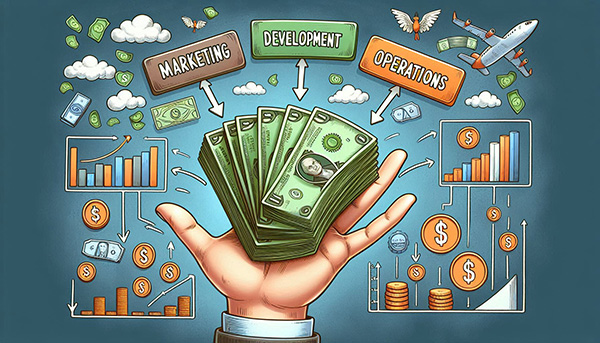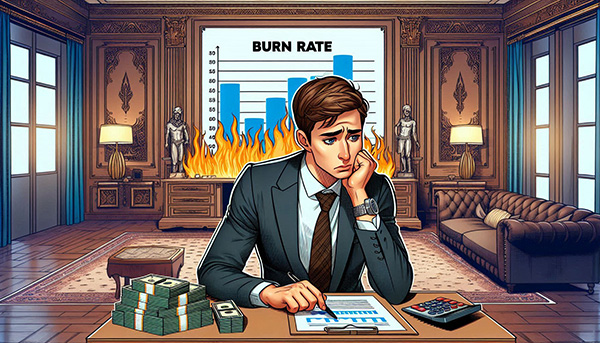By: John S. Morlu II, CPA
Introduction: The Dream of WobbleTech
In the bustling heart of Startupville, where the air crackled with the electricity of new ideas and every coffee shop was a hive of entrepreneurial chatter, resided Bob Wobbleton. Startupville was a city where innovation wasn’t just a buzzword but a way of life, and every corner was filled with the heady aroma of freshly brewed coffee and freshly minted dreams.
Bob Wobbleton, a local with an insatiable appetite for success and a head full of groundbreaking ideas, had a vision that set him apart from the rest. His brainchild was WobbleTech, a company he believed would not only capture the imagination of the world but also catapult him into the elite ranks of unicorn founders. In startup lingo, a unicorn isn’t a mythical beast but a startup that has achieved a valuation of over $1 billion. Bob saw WobbleTech as his ticket to this exclusive club, a game-changer destined to redefine its industry.
But, as with many grand visions, Bob’s dream was tethered by a significant challenge: he needed $2 million to turn his ideas into reality. The road to securing such an amount, however, was not paved with ease. It was lined with complex financial jargon and rigorous scrutiny—a daunting landscape for anyone lacking in financial finesse.
Undeterred by the intimidating nature of venture capital, Bob’s optimism was as boundless as his ambition. He set his sights on Mr. Percival Goldleaf, a name synonymous with angel investing in Startupville. Mr. Goldleaf was not just an investor; he was a legend, a man whose approval could turn a fledgling startup into a phenomenon. His office, rumored to be adorned with gold accents and an air of old-world charm, was the very citadel of financial success.
With nothing more than a heart full of passion and a hastily scribbled financial plan on a coffee-stained napkin, Bob prepared for what he hoped would be the meeting that launched WobbleTech into the stratosphere. He envisioned the meeting as a straightforward pitch, a chance to dazzle Mr. Goldleaf with his boundless enthusiasm and a vision so brilliant it would require no further validation.
Yet, Bob was about to embark on a journey that would challenge his perceptions of the startup world. The meeting, which he had envisioned as a golden opportunity, was about to unravel into a labyrinth of financial terms and investor interrogations. It would test not only his resolve but also his grasp of the essential elements that underpin a successful startup. What Bob thought was a simple pitch would soon reveal itself as an intricate dance of financial acumen and strategic planning—a gauntlet he was woefully unprepared to navigate.
Thus began Bob Wobbleton’s odyssey—a quest not just for investment but for understanding, preparation, and a deeper appreciation of what it truly takes to turn a grand vision into a billion-dollar reality.
Chapter 1: The Encounter with Mr. Goldleaf
Bob Wobbleton took a deep breath and stepped into the imposing office of Mr. Percival Goldleaf, clutching his “Visionary Spreadsheet” like a precious artifact. The office itself was a testament to Mr. Goldleaf’s financial prowess—a gleaming palace of opulence where golden accents shone as brightly as the investor’s reputation. The velvet chairs looked as if they had been plucked straight from a royal throne room, promising comfort to those fortunate enough to sit in them. And presiding over the entire scene was a large portrait of Mr. Goldleaf himself, casting a knowing gaze over the room as if to say, “Yes, I am as important as this painting makes me look.”
Bob’s heart raced with a mix of excitement and trepidation. He had envisioned this moment countless times, but nothing could have prepared him for the grandeur of Mr. Goldleaf’s domain. He squared his shoulders, straightened his tie, and approached the sleek mahogany desk where Mr. Goldleaf lounged like a king surveying his kingdom.
“Mr. Goldleaf,” Bob began, his voice brimming with enthusiasm, “I’m here to present WobbleTech, a venture that’s set to become the next unicorn. We’re talking about a company that will redefine the industry and take the world by storm. All I need is $2 million to get started.”
Mr. Goldleaf’s eyes twinkled with the kind of amusement one might reserve for a particularly entertaining circus act. He leaned back in his chair, his trademark smirk spreading across his face. “Fantastic, Bob. I love enthusiasm. But before we dive into the glittering world of unicorns, let’s first wade through the murky waters of financials. Let’s start with your financial model.”
Bob’s face turned a shade of pale that would have done any ghost proud. He had prepared a document that he fondly referred to as his “Visionary Spreadsheet.” This document was a colorful explosion of numbers and pie charts that looked more like a kindergarten art project than a serious financial plan. It had been scribbled hastily on a napkin during a particularly caffeinated brainstorming session, and now it was the cornerstone of his pitch.
With a trembling hand, Bob handed over the napkin, hoping against hope that Mr. Goldleaf’s legendary investor instincts would somehow overlook the chaotic mess he was presenting.
Mr. Goldleaf took the napkin with a raised eyebrow and examined it with the kind of scrutiny usually reserved for ancient artifacts. His amusement was barely concealed, as he noted the doodles of rainbows and smiley faces alongside the numbers. “Interesting,” he said, trying to suppress a chuckle. “Now, let’s talk about your runway and run rate.”
Bob’s heart sank. He had heard these terms before—mostly in passing conversations and tech podcasts—but their meanings had always eluded him. He was now face-to-face with the harsh reality that understanding these terms was not optional but essential.
“Uh, runway?” Bob began, his voice faltering. “I’m guessing it’s like how long a plane can fly before it needs to land?”
Mr. Goldleaf’s eyes glinted with amusement. “Close, but not quite. The runway is actually the amount of time your company can operate before it runs out of cash.”
Bob scratched his head. “So… it’s like how long we can keep our lights on before we… need more money?”
“Exactly,” Mr. Goldleaf said, nodding encouragingly, “but with a bit more financial rigor involved.”
“Great,” Bob said, trying to sound confident. “And the run rate?”
Mr. Goldleaf leaned forward, his smirk widening. “The run rate is a projection of how much revenue you’ll generate based on your current performance.”
Bob blinked, trying to process the information. “So it’s like predicting how many miles I can run based on how fast I’m running now?”
Mr. Goldleaf’s chuckle escaped freely now. “In a sense, yes. But instead of miles, we’re talking dollars.”
Bob took a deep breath. He was beginning to realize that his understanding of financial terms was as rudimentary as his napkin-based financial plan. As Mr. Goldleaf continued to pepper him with questions about EBITDA, Free Cash Flow, and Uses of Funds, Bob felt like he was trying to solve a Rubik’s Cube while blindfolded. Each term was a new puzzle piece he struggled to fit into the broader picture of his startup dream.
The more Mr. Goldleaf prodded, the more Bob felt like a contestant on a game show where the questions were designed to expose his ignorance rather than reward his knowledge. Mr. Goldleaf’s questions came with a kind of elegant cruelty, designed not just to test Bob’s knowledge but to highlight the gaps in his preparation.
Despite Bob’s best efforts to appear knowledgeable, it became increasingly clear that his grand vision for WobbleTech was no match for the financial acumen required to secure $2 million. Bob’s dream of impressing Mr. Goldleaf was rapidly morphing into a nightmare of financial faux pas.
As the meeting continued, Bob’s once-bold optimism began to wane. Each question from Mr. Goldleaf was a reminder that securing investment was not just about having a groundbreaking idea but also about being prepared to answer tough, financial questions. The grandeur of Mr. Goldleaf’s office seemed to mock Bob’s lack of preparation, and the portrait of Mr. Goldleaf hung over him like a silent, judgmental observer.
By the time the meeting concluded, Bob left Mr. Goldleaf’s office with a mix of embarrassment and enlightenment. He had come to realize that turning WobbleTech into the next unicorn was not just a matter of having a grand vision but also of mastering the financial intricacies that would underpin its success.
And so, with a heavy heart and a newfound determination, Bob set out to remedy his lack of financial knowledge. He knew that if he wanted to impress investors like Mr. Goldleaf and turn his unicorn dreams into reality, he would need to arm himself with more than just passion and a colorful napkin.
Chapter 2: The Financial Gauntlet
Bob Wobbleton was in a state of utter befuddlement. After his less-than-stellar encounter with Mr. Percival Goldleaf, he knew he had to up his game. The problem was, he had never truly understood the financial jargon that flowed through the startup world like a relentless torrent of confusion. The terms that had once seemed like abstract concepts now appeared as formidable obstacles in his quest for $2 million. With an air of determination—and a hint of panic—Bob decided to tackle the financial gauntlet head-on.
The next day, Bob found himself in the midst of a whirlwind financial crash course. He had scoured the internet, enlisted the help of an overly enthusiastic accountant named Sheila, and even tried to decipher cryptic finance memes. But as he prepared for his next pitch, the terminology still danced around his head like mischievous fairies.
Runway
Bob’s first challenge was understanding “runway.” In the startup world, runway referred to the amount of time a company could operate before it needed more money. To Bob, though, it sounded like something out of a high fashion show.
During a mock pitch with Sheila, Bob said, “Our runway is very long, like an airport runway. We’ve got plenty of time before we need to land.”
Sheila gave him a bemused look. “Bob, when investors talk about runway, they mean how long your current funds will last, not whether you’ve got room for a jet.”
“Ah,” Bob said, scratching his head. “So, no actual planes involved?”
Run Rate
Next up was “run rate.” Bob had heard this term tossed around like it was some sort of magical incantation. He decided to focus on the “run” part of the term, thinking it might be connected to physical exercise.
In another practice session, Bob announced with confidence, “Run rate is… how fast we run?”
Sheila, now a mix of amused and exasperated, replied, “Bob, run rate is a financial metric that estimates your company’s performance over time based on current data.”
Bob nodded sagely. “Got it. So it’s like my marathon training schedule but for money?”
“Sort of,” Sheila said, “except no actual running involved.”
EBITDA
“EBITDA” was a term that sounded like an alien language. It stood for Earnings Before Interest, Taxes, Depreciation, and Amortization, and Bob was convinced it must be a new tech term or possibly the name of a trendy startup.
During his attempt to master EBITDA, Bob said, “EBITDA? Sounds like a new tech term. Is it some sort of futuristic robot?”
Sheila tried to suppress a giggle. “No, Bob. EBITDA is a measure of your company’s profitability before you account for interest, taxes, depreciation, and amortization. It’s like your financial health check-up.”
Bob’s eyes glazed over. “Ah, so it’s like a high-tech health monitor but for money?”
Free Cash Flow
“Free Cash Flow” was another term that made Bob’s brain do somersaults. To him, free cash sounded like the kind of cash you’d get from a really generous uncle at Christmas.
Bob announced with a hopeful grin, “Free Cash Flow… like free cash that flows? Is it some kind of financial fountain?”
Sheila sighed and said, “It’s actually the cash left over after you’ve covered your capital expenditures. It’s what you use for investments or paying off debts.”
“Oh,” Bob said, trying to look enlightened. “So it’s not literally flowing cash but more like the leftovers after a big financial feast.”
Uses of Funds
When it came to “Uses of Funds,” Bob thought he had this one nailed. He had plans for a lot of “awesome stuff,” which he was sure would impress anyone.
At his next practice pitch, Bob declared, “We’ll use the $2 million for awesome stuff! You know, like buying the coolest tech and hiring top talent.”
Sheila looked pained. “Bob, investors want specifics. They want to know exactly how you’ll allocate the funds—what portion goes to development, marketing, operations, etc.”
Bob was momentarily stumped. “So, it’s not just about the awesomeness of the stuff?”
“Nope,” Sheila replied. “It’s about the details.”
Traction
Bob had a general idea of “traction,” but he was under the impression it involved some sort of physical traction.
He told Sheila, “We have a bunch of people interested. We’re getting lots of traction!”
Sheila asked, “How many users or customers have you actually acquired?”
Bob paused. “Well, we’ve got a lot of people saying they love the idea. Does that count?”
“Not quite,” Sheila said. “Traction refers to actual metrics and customer acquisition. You need numbers and evidence of growth.”
Offerings
Bob’s understanding of “Offerings” was that of a fancy menu at a high-end restaurant. He assumed investors were interested in the menu of services or products he was offering.
He proudly said, “We offer cutting-edge solutions. Very unique.”
Sheila raised an eyebrow. “Bob, what exactly are you providing? What makes your offerings special compared to competitors?”
Bob, somewhat flustered, replied, “We offer very unique stuff… like really special tech that’s going to change everything!”
Sheila sighed. “Investors need specifics, Bob. They want to know what problems you’re solving and how you’re doing it.”
Gross Margin and Profit Margin
Finally, Bob faced the duo of “Gross Margin” and “Profit Margin.” To him, gross margin sounded like a really gross bar snack, while profit margin was the margin you made on your favorite shopping spree.
In his attempt to understand, Bob said, “Gross Margin is the gross stuff, and Profit Margin is how much we profit. Right?”
Sheila chuckled. “Gross Margin is your sales minus the cost of goods sold, and Profit Margin is your net profit as a percentage of sales. They’re both key to understanding your profitability.”
Bob scratched his head. “So Gross Margin is the stuff that gets left over after making the sales, and Profit Margin is the percentage of what’s left that’s actually profit?”
“Exactly,” Sheila said, finally seeing a glimmer of comprehension in Bob’s eyes.
As Bob continued to grapple with the financial jargon, he found himself more confused than ever. Each term seemed like a riddle wrapped in a mystery, and he was beginning to feel like a contestant on a high-stakes game show where the prize was not losing his startup dreams.
Determined to master the financial lingo and impress Mr. Goldleaf on his next attempt, Bob knew he had to embrace these concepts with more than just a cursory understanding. If WobbleTech was to soar to unicorn status, Bob needed to ensure he was fluent in the language of finance, not just a well-meaning enthusiast with a knack for colorful spreadsheets.
With a mix of trepidation and resolve, Bob dove back into his financial studies, ready to face the next pitch with the knowledge and confidence he hoped would finally crack the code to winning over investors.
Each question seemed to deepen Bob’s confusion, as he struggled to keep up with the barrage of financial jargon. His attempts to provide answers only highlighted his lack of preparation and understanding.
Chapter 3: The Realization
The meeting with Mr. Percival Goldleaf continued, and Bob Wobbleton’s once-pristine aura of optimism was beginning to crack like a poorly made soufflé. Each probing question from Mr. Goldleaf felt like a sledgehammer smashing through Bob’s confidence, and his grand vision of WobbleTech as the next unicorn seemed to drift further away with each financial term he stumbled over.
As Mr. Goldleaf launched into another round of financial jargon, Bob could feel the pressure mounting. His grand vision of a billion-dollar startup was rapidly deflating like a birthday balloon losing air.
“Bob,” Mr. Goldleaf said, adjusting his golden cufflinks with a smirk that was part amusement, part sympathy, “we need to discuss your cash flow projections. How do you plan to manage your cash flow over the next 12 months?”
Bob, who had been picturing a flowing river of money, responded with hopeful enthusiasm, “We’ll manage our cash flow like a water park, with lots of splashy fun!”
Mr. Goldleaf’s smile was now tinged with a mixture of pity and a touch of disbelief. “Bob, cash flow isn’t about creating a theme park. It’s about understanding the timing of your income and expenses, ensuring you have enough liquidity to keep your operations running smoothly.”
Bob’s face flushed a deep shade of crimson. He had hoped his enthusiastic, albeit misguided, answers would be enough to impress. Instead, he was beginning to realize that passion alone was not going to cut it. The financial gauntlet he was facing was much more demanding than he had anticipated. He had to understand these terms deeply, not just toss around whimsical analogies.
Mr. Goldleaf leaned back in his chair, his patience evident but his disappointment unmistakable. “Bob, the essence of these financial terms is to gauge your company’s potential and viability. Without a solid understanding of these concepts, it’s challenging to justify an investment.”
Bob’s heart sank. He hadn’t anticipated such a rigorous interrogation. The unicorn he had envisioned—a mythical creature galloping towards a billion-dollar valuation—was now looking like a distant mirage in the desert. As Mr. Goldleaf continued to dissect his financial strategy with surgical precision, Bob felt increasingly overwhelmed and embarrassed.
“Let’s talk about your burn rate,” Mr. Goldleaf said. “It’s crucial to know how quickly you’re spending your capital.”
Bob, now grasping at straws, tried to recall anything he had read about burn rates. “Burn rate… like how quickly our company will become a smoldering wreck?”
Mr. Goldleaf couldn’t help but chuckle, though his eyes remained stern. “Not quite. Burn rate is the rate at which you’re spending your capital before reaching profitability. It’s essential to track this so you can manage your expenses and avoid running out of money.”
Bob’s shoulders slumped as he nodded, trying to reconcile his idealistic dreams with the harsh reality of financial management. He was beginning to grasp the enormity of his oversight. His preparation had been woefully inadequate, and the grandiose idea of launching a unicorn startup without a solid financial foundation was proving to be a naive fantasy.
Mr. Goldleaf’s tone softened slightly as he continued, “Raising money isn’t just about having a great idea. It’s about being prepared to answer tough questions and showing that you’ve thoroughly thought through your business’s financial health. If you want $2 million, you need to demonstrate that you’re not just a dreamer but a well-prepared entrepreneur.”
Bob felt a wave of embarrassment wash over him. He had approached the meeting with enthusiasm but without the necessary preparation. The unicorn he had imagined now seemed like a mirage fading into the distance. The stark reality of the startup world was hitting him hard, and it was clear that he needed more than just passion to attract investors.
As Mr. Goldleaf continued with his questions, Bob found himself reflecting on his approach. He realized that while his dreams and enthusiasm were valuable, they needed to be backed up by a thorough understanding of financial principles and a well-prepared business strategy. The unicorn he aspired to create wasn’t just about lofty dreams but about a grounded and realistic approach to business.
With newfound determination, Bob decided that he wouldn’t let this setback be the end of his journey. He would dive into financial literacy, learn the intricacies of cash flow, burn rates, and all the other crucial aspects of running a successful startup. He would turn his vision into a reality by becoming the entrepreneur who not only dreamed big but also prepared meticulously.
As he left Mr. Goldleaf’s office, Bob’s head was held high, not with the bravado of a dreamer but with the resolve of a determined learner. He knew that the road to building WobbleTech into the next unicorn would be long and challenging, but he was ready to face it with a newfound understanding of the financial landscape and a commitment to turning his dreams into a well-prepared reality.
Chapter 4: The Journey Back
Bob Wobbleton shuffled out of Mr. Percival Goldleaf’s office, his spirit buoyed by a cocktail of humility and enlightenment. The golden grandeur of the office faded behind him as he stepped back into the bustling streets of Startupville, where the pavement seemed to echo with the cries of yet-to-be-made unicorns.
Bob’s dream of WobbleTech had just hit a speed bump the size of a small asteroid, but he wasn’t about to let it crater his ambitions. He had learned a critical lesson: while having a vision was like having a golden ticket, understanding the financial landscape was akin to knowing how to get to the amusement park and actually enjoy the rides. With this newfound clarity, Bob was determined to become not just another dreamer but a financially savvy entrepreneur.
Armed with a notebook brimming with scribbled financial terms and a head full of bewildering jargon, Bob embarked on what he humorously dubbed “The Financial Odyssey.” His first stop was the Startupville Financial Academy, where he attended workshops led by experts who spoke in a language that sounded more like a foreign dialect than actual English. Terms like “EBITDA” and “Free Cash Flow” danced around in his head like elusive fireflies.
At the workshop, Bob tried to keep up. The instructor, Ms. Penny Worth, stood at the front, enthusiastically explaining the importance of understanding one’s “runway.” Bob raised his hand, keen to contribute, “So, runway is like when you’re at the airport, and you have to wait for the plane to take off before it flies, right?”
Ms. Worth, who had a patience level rivaling that of a saint, nodded with a polite smile. “Not exactly. It’s actually about how long you can sustain operations before needing additional funding. It’s less about literal runways and more about your financial runway.”
Bob scribbled notes furiously, his face a mask of concentration. Next, the session delved into EBITDA. Bob’s mind wandered briefly to the possibility of EBITDA being a new breed of exotic pet, but he managed to focus as Ms. Worth explained, “EBITDA stands for Earnings Before Interest, Taxes, Depreciation, and Amortization. It’s a measure of your company’s profitability before these costs.”
Bob furrowed his brow and wrote, “EBITDA = Earnings – Interest – Taxes – Deprecation – Amortization = Pet?”
The workshop concluded with a practical exercise. Bob was paired with a financial wizard named Lucy Ledger, who had a knack for making numbers seem like characters in a grand play. “Let’s work on your financial model,” Lucy said, her enthusiasm as contagious as a yawn at a boring lecture. “Start by outlining your revenue streams and expenses.”
Bob, still in a state of bewildered optimism, began to sketch out his plan. “We’ll have revenue from sales, and expenses for everything we need to make the sales happen… like lots of coffee for the team.”
Lucy, who had seen many a hopeful entrepreneur, raised an eyebrow. “That’s a start, but you’ll need to be more detailed. Think about costs like salaries, marketing, and operational expenses. And remember, you need to project how much cash you’ll need to keep the lights on.”
Bob’s eyes widened. “You mean, the coffee alone won’t cover it?”
Lucy smiled, a knowing look in her eyes. “Not quite. It’s crucial to understand how your money flows in and out of the business to avoid running out of steam.”
With Lucy’s help, Bob began to see the light. His once hazy vision of financial management started to crystallize into something tangible. He learned to build a realistic financial model, create projections for his runway, and properly allocate his Free Cash Flow. Each concept became less of an enigma and more of a vital tool in his entrepreneurial toolkit.
In addition to workshops, Bob sought advice from seasoned financial advisors and even hired a consultant named Sam Spreadsheets, who had a reputation for turning financial chaos into orderly reports. Sam, who wore glasses so thick they could double as magnifying glasses, helped Bob refine his business plan, focusing on key metrics like Gross Margin and Profit Margin.
One particularly illuminating moment came when Sam explained the concept of “Uses of Funds.” Bob had initially thought this meant using the funds for “cool stuff,” but Sam patiently guided him through detailed budget allocation, from product development to marketing and operational costs.
Bob spent countless hours immersed in financial literature, attending seminars, and practicing his pitch. He even started to view spreadsheets as a creative outlet rather than a source of dread. His once-confusing financial model evolved into a comprehensive, meticulously detailed plan that could impress even the most skeptical investor.
As Bob prepared for his next pitch, he felt a sense of readiness he hadn’t experienced before. He could now confidently discuss his runway, run rate, EBITDA, and all the other terms with clarity and assurance. His dream of WobbleTech had evolved from a whimsical notion to a well-thought-out plan backed by solid financial groundwork.
In the end, Bob’s journey was not just about understanding financial metrics; it was about transforming his approach to entrepreneurship. He realized that while dreams are essential, they need to be anchored in reality to become successful ventures. With his newfound knowledge and improved business plan, Bob was ready to tackle the next investor meeting with a blend of enthusiasm and financial acumen.
As he walked through the streets of Startupville, Bob couldn’t help but smile. He had turned a humbling experience into a valuable lesson and was now equipped to turn his unicorn dreams into a reality. The road ahead was still filled with challenges, but Bob was no longer just a dreamer; he was a well-prepared entrepreneur ready to conquer the world of startups.
Conclusion: The Road to Unicorns
Bob Wobbleton’s odyssey from a dreamer with a scattershot financial plan to a strategic entrepreneur with a bulletproof financial model is a journey that resonates far beyond the confines of Startupville. His transformation was not just about understanding the esoteric language of finance; it was about learning that the road to unicorns is paved not only with ambition but with rigorous preparation and unwavering perseverance.
Bob’s initial foray into the world of venture capital was akin to setting sail without a map or compass. His encounter with Mr. Percival Goldleaf had been both an exhilarating ride and a brutal reality check. It was a dramatic clash between boundless enthusiasm and the stark, unyielding metrics of financial viability. Yet, through this crucible of scrutiny, Bob emerged with clarity and newfound wisdom.
Equipped with a comprehensive financial model that was no longer scribbled on a napkin but meticulously crafted, Bob understood that runway and run rate were not just jargon but crucial indicators of how long his dream could fly before needing more fuel. EBITDA and Free Cash Flow were no longer abstract concepts but concrete measures of profitability and financial health. Armed with this knowledge, Bob was no longer just presenting an idea; he was showcasing a robust, data-backed plan.
Returning to Mr. Goldleaf’s office, Bob did so with a quiet confidence, grounded not in the naivety of unchecked dreams but in the hard-earned expertise of a seasoned entrepreneur. This time, Mr. Goldleaf’s once skeptical gaze transformed into one of genuine interest and respect. The unicorns Bob had once pursued in the clouds now seemed within reach, their elusive shimmer made tangible by the meticulous planning and preparation that Bob had embraced.
Bob Wobbleton’s story is more than just a tale of startup success; it’s a beacon for all those chasing their own unicorns. It’s a reminder that dreams are essential—they ignite the spark of possibility. But without the rigorous discipline of financial acumen and the fortitude to endure and learn from setbacks, those dreams can remain just that—distant, shimmering illusions.
In the grand tapestry of entrepreneurial journeys, Bob’s narrative stands as a powerful testament to the synergy between vision and preparation. It illustrates that while the allure of unicorns might drive the dream, it is the groundwork laid in spreadsheets, projections, and financial foresight that truly brings the dream closer to reality.
Bob’s triumphant return to Mr. Goldleaf, armed with his refined strategy, symbolized not just a personal victory but an emblem of what every aspiring entrepreneur must achieve: the balance between visionary ambition and grounded pragmatism. The unicorns, once an enchanting but distant fantasy, were now on the horizon, waiting to be chased down with both magic and method.
In the end, Bob’s tale is a powerful affirmation that the road to unicorns is not a whimsical path but a journey of transformation—one where dreams are tethered to reality, and success is built on the solid foundation of preparation and perseverance. The magical creatures of the startup world may be elusive, but with the right tools and mindset, they are well within reach. And Bob Wobbleton, now a seasoned navigator of the startup seas, was more than ready to make that leap and catch his unicorns.
Author: John S. Morlu II, CPA is the CEO and Chief Strategist of JS Morlu, leads a globally recognized public accounting and management consultancy firm. Under his visionary leadership, JS Morlu has become a pioneer in developing cutting-edge technologies across B2B, B2C, P2P, and B2G verticals. The firm’s groundbreaking innovations include AI-powered reconciliation software (ReckSoft.com) and advanced cloud accounting solutions (FinovatePro.com), setting new industry standards for efficiency, accuracy, and technological excellence.
JS Morlu LLC is a top-tier accounting firm based in Woodbridge, Virginia, with a team of highly experienced and qualified CPAs and business advisors. We are dedicated to providing comprehensive accounting, tax, and business advisory services to clients throughout the Washington, D.C. Metro Area and the surrounding regions. With over a decade of experience, we have cultivated a deep understanding of our clients’ needs and aspirations. We recognize that our clients seek more than just value-added accounting services; they seek a trusted partner who can guide them towards achieving their business goals and personal financial well-being.
Talk to us || What our clients says about us














